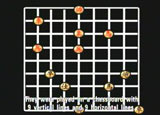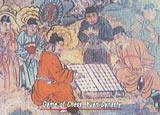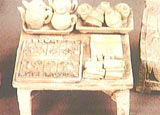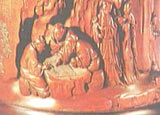 |
|
Chinese Chess |
| CCTV.COM 2003-12-02 13:12:31 |
|
 Chinese chess has a long history. Its origin has not been confirmed yet. But judging by its rules, we can conclude that the origin of Chinese chess was closely related to military strategists in ancient China. Chinese chess has a long history. Its origin has not been confirmed yet. But judging by its rules, we can conclude that the origin of Chinese chess was closely related to military strategists in ancient China.
During the Spring and Autumn Period and the Warring States Period, wars were fought for years running. A new chess game was patterned after the array of troops. This was the earliest form of Chinese chess.
“People argue that the Chinese chess originated from Shun, a legendary sage monarch in ancient China, or from King Wu of Zhou, or from “The Book of Changes”, or from the Han Dynasty. In fact, these arguments are not reliable. Judging from the pieces, we can say the origin of Chinese chess was closely related to military affairs in ancient times. The Chinese chess took shape during the Spring and Autumn Period and the Warring States Period,” said Cui Lequan, research fellow of China Sports Museum.
 During the Wei, Jin and Northern and Southern Dynasties, a kind of chess game was popular among the people. It laid a foundation for the finalized pattern of the Chinese chess. During the Wei, Jin and Northern and Southern Dynasties, a kind of chess game was popular among the people. It laid a foundation for the finalized pattern of the Chinese chess.
In ancient times, the Chinese chess was always enjoyed by both highbrows and lowbrows.
“During the reign of Suzong of Tang Dynasty, Prime Minister Niu Sengru wrote a fake story about chess. That occurred during the Baoying period, so it was named Baoying chess. Baoying chess had six pieces. He wrote about the rules of the chess. Baoying chess produced a significant influence on the chess in subsequent years,” said Cui Lequan, research fellow of China Sports Museum.
 Baoying chess consisted of six kinds of pieces, namely, the king, the military counselor, the horse, the elephant, the chariot and the pawn. A series of changes were made later. The pattern and rules of the Chinese chess were finalized during the Northern Song Dynasty and have lasted to this day. In July 1997, archaeologists found 32 round chess pieces of porcelain from a tomb of the Northern Song Dynasty in Luoyang City, Henan Province. The structure of the chess is identical to that of the modern Chinese chess. Baoying chess consisted of six kinds of pieces, namely, the king, the military counselor, the horse, the elephant, the chariot and the pawn. A series of changes were made later. The pattern and rules of the Chinese chess were finalized during the Northern Song Dynasty and have lasted to this day. In July 1997, archaeologists found 32 round chess pieces of porcelain from a tomb of the Northern Song Dynasty in Luoyang City, Henan Province. The structure of the chess is identical to that of the modern Chinese chess.
“Three forms of chess took shape after the Song Dynasty. One of them consisted of 32 pieces. They were played on a chessboard with 9 vertical lines and 9 horizontal lines. Popular in those days was a chessboard without a river borderline. The Chu River and Han Borderline were added later. This form has lasted to this day,” said Cui Lequan, research fellow of China Sports Museum.
 With the economic and cultural development during the Qing Dynasty, the Chinese chess entered a new stage. Many different schools of chess circles and chess players came into prominence. With the popularization of the Chinese chess, many books and manuals on the techniques of playing chess were published. They played an important role in popularizing the Chinese chess and improving the techniques of playing in modern times. With the economic and cultural development during the Qing Dynasty, the Chinese chess entered a new stage. Many different schools of chess circles and chess players came into prominence. With the popularization of the Chinese chess, many books and manuals on the techniques of playing chess were published. They played an important role in popularizing the Chinese chess and improving the techniques of playing in modern times.
|
|
Editor: Han Ling CCTV.com
|
|
|
|
|
|
 |









